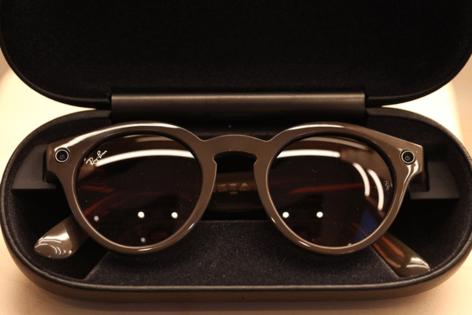How Meta's upcoming $1,000+ smart glasses with a screen will work
Published in Business News
Meta Platforms Inc., ramping up work on a deluxe version of its popular smart glasses, plans to include hand-gesture controls and a screen for displaying photos and apps.
The company intends to introduce its first glasses with a screen as early as the end of this year — a product it sees as a key step toward providing an alternative to Apple Inc.’s iPhone and other mobile devices, according to people familiar with the matter.
Meta employees estimate pricing for the device, which is code named Hypernova, will come in at over $1,000 and as high as $1,300 to $1,400, said the people, who asked not to be identified discussing unannounced products. The final price is unlikely to be decided until closer to an announcement.
The company’s current smart glasses, the Ray-Ban Meta Glasses, start at $299 and have been a surprise hit. Meta will continue to sell that entry-level version and is banking on their popularity to push users toward the higher-end models. Other companies, including Amazon.com Inc., have pledged new versions of their own glasses to better compete with the social networking giant.
The significant price increase for the new model is driven almost entirely by the screen, which is a monocular panel that will be located in the lower-right quadrant of the right lens. That means information will only be displayed in front of the wearer’s right eye and will appear most clearly when they are looking downward.
The company has already begun work on a second-generation version of the product, codenamed Hypernova 2. The major difference is the inclusion of a binocular display system, which means the device will have two screens and show information in both eyes. That device is currently planned for 2027, the people said.
The glasses with screens will mark another stepping stone toward Meta’s vision of true augmented reality glasses, which the company previewed last year. A Meta spokesperson declined to comment.
A look at a prototype version of the first Hypernova glasses indicates how the glasses are likely to work when they go on sale.
—When they are turned on, the display shows a “boot screen” with logos for Meta and other partners — such as chipmaker Qualcomm Inc. — on the product.
—Once the device is on, the user will see a home screen comprised of circular icons laid out horizontally, similar to the app dock on Apple devices or Meta’s Quest mixed-reality headset.
—The glasses include dedicated apps for taking pictures, viewing photos and accessing maps. There is also support for notifications from phone apps, including Meta’s Messenger and WhatsApp.
—The glasses will otherwise work similarly to the current Wayfarer-style Ray-Ban Metas, focusing on capturing images and video, accessing AI via built-in microphones and pairing with a phone for calls and music playback. The new version will continue to rely heavily on the Meta View phone app.
—Like Meta’s other new devices, the glasses will run a highly customized version of the Android operating system from Alphabet Inc.’s Google. The company isn’t currently planning to include an on-board app store.
—Users will be able to control the glasses using capacitive touch controls on the sides of the glasses, meaning they can scroll through apps or photos by swiping against the temple bars and then tapping to open something specific.
—Meta also plans to begin offering a so-called neural wristband for the first time, which will allow a wearer to control the glasses with gestures, such as rotating their hand to scroll through apps and photos and pinching their finger and thumb to select items. Meta is currently planning to bundle the accessory, codenamed Ceres, in the box with the glasses.
Meta also plans to upgrade the camera. Internally, the company considers the 12-megapixel camera on the current models on par with an iPhone 11 from 2019. For the new model, it would like to rival the iPhone 13 from 2021, the people said. It’s also planning a new carrying case dubbed Heres, which is shaped like a triangular prism and folds up.
The Hypernova glasses are still months away from being introduced, and the company’s current plans could change. Meta is known for making product changes — or even axing new initiatives — late in the development process. About 18 months ago, it canceled a variant of the Ray-Ban Metas with the camera removed. That device, codenamed Luna, was designed to bring down costs and increase privacy, the people said.
Besides the Hypernova glasses, Meta is also finishing up work on new smart glasses without a display dubbed Supernova 2. They will operate similarly to today’s Ray-Ban Metas, but will instead be built on a glasses design from Oakley, Bloomberg has reported. This pair will be optimized for athletic use, including biking. The company recently began testing in public environments.
The Hypernova follow-up project for 2027 sets up some overlap with Meta’s work on true augmented reality glasses, which overlay interactive images, video and information over the real world. Those products require more advanced and expensive technology than the simpler so-called heads-up displays in the Hypernova devices.
The company last year announced prototype AR glasses dubbed Orion, but the the first version for actual customers is likely to be a follow-up product dubbed Artemis, Bloomberg has reported. It’s using Orion internally for software testing and app development purposes — and could ultimately seed it to developers. The Artemis device likely won’t arrive before 2027.
There are questions within Meta’s Reality Labs division, which develops these products, as to whether Meta will ultimately combine the Artemis and Hypernova products or if they’ll eventually arrive separately at distinct price points, the people said.
(With assistance from Riley Griffin.)
©2025 Bloomberg L.P. Visit bloomberg.com. Distributed by Tribune Content Agency, LLC.












Comments